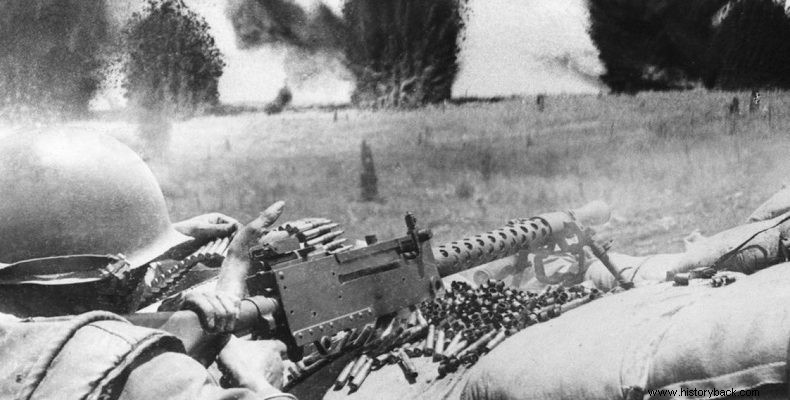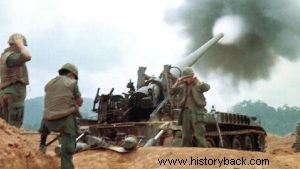
Ke Sanh's base was located in northwestern Vietnam, 10 km from the border with Laos. The base, since its establishment in 1962, has been a thorn in the side of the Ho Chi Minh corridor. American special forces advisers and a South Vietnamese garrison were stationed there. The base was not attacked until January 1966, when it was shelled by North Vietnamese artillery, with meager results.
A year later the guarding of the base was taken over by the marines, who also built an airstrip, 1,200 meters long. However, the base was not easy to defend, since it was created in a valley, surrounded by many wooded hills. Even the water supply came from a small river that ran through the base, but it came from enemy-controlled territory. During the winter months, fog covered the base for many hours of the day, limiting visibility.
In December 1967 the US commander in chief in Vietnam William Westmoreland had deployed South Vietnamese forces near the base as he had information that a major enemy attack against it was imminent. He believed that the Northerners intended to make Ke San the American Dien Bien Phu. It was about the attack on Wednesday. However, the Northerners did not have as their primary objective the capture of the base.
The attack against her would act as a distraction, for the purpose of anchoring South Vietnamese and American forces. Only after their disastrous defeat did they set the capture of the base as their main objective in order to present a victory.
The North Vietnamese had begun to take up positions in the hills surrounding the base by mid-December, taking advantage of the fog. Nearly a month later, on January 20, a North Vietnamese POW revealed to the Americans that a major attack on the base was imminent. The news was immediately transmitted to Washington, where President Johnson, after communicating with Westmoreland, ordered that every possible measure be taken to repel the enemy.
Supply
In the early morning of January 21st, fog was enveloping the small valley of Ke Shan. Everything was peaceful. Suddenly a whistle was heard. Immediately followed by shouts, screams. With a bayonet weapon, a North Vietnamese company attacked one of the dozens of outposts installed around the perimeter of the base. The marines who made up the garrison fought bravely and repulsed the attack.
A few moments later, however, the surrounding hills flashed. Dozens of artillery and mortar shells erased their trajectories in the air and ended up on the airstrip and the base's main ammunition depot. The airstrip was put out of service as its aluminum frames disintegrated. At the same time, 1,340 tons of ammunition were thrown into the air, creating a small volcano, where the ammunition depot used to be.
Then only the garrison, the 26th Marine Regiment, realized what was happening. Colonel John Padley and his 3,500 men were taken by surprise , not from the attack, but from the intensity and density of the fire. Marines immediately manned their battle positions and the thousands of Vietnamese civilians living and working on the base were evacuated by helicopter.
The engineering division of the marines – the famous Sea Bees – they immediately set to work repairing the runway, despite enemy fire, since the runway was the only artery that could keep the base alive. A section of the runway was repaired and the small C-123 Providers managed to land the very next day, carrying 3,630 kg of ammunition.
Continuous attacks and tactical moves
By the evening of January 22, 116 tons of ammunition had arrived at the base by air, a fact indicative of the skill and determination of both the marine pioneers and the transport operators . At the same time, another battalion of Marines arrived at the base – the 1st of the 9th Regiment – and with it arrived Colonel David Lowds, who took command. At that time, he had under his command, 4 full battalions of marines and an artillery squadron. On January 26, the 37th Rangers Battalion of the South Vietnamese Army also arrived at the base.
Before launching their attack the North Vietnamese had taken care to surround and blockade the base. The Americans had placed electronic vibration detectors around the base, which detected ground vibrations caused by enemy supply convoys. But they had not had time to put the whole system into operation before the battle began.
But they decided to place 250 of these sensors near the base as early warning devices for the garrison. Acoustic sensors were also placed in the trees. Thanks to these devices, the Americans realized in time the intention of their opponents to occupy a dominant hill of the base, Hill 861 A. They did not have time, or neglected to inform the men who had settled defensively on the hill.
The North Vietnamese moved from Hill 881, south of 861. The enemy force split into two divisions. The first attacked the defenders of 861 by surprise. The Americans, panicked, abandoned their positions. Luckily for them, their leader, Lt. Donald Shanley, was able to regroup and fight back!
One of the worst hand-to-hand combats ever fought followed. The few Americans fought heroically, with grenades, with the butts of their weapons, with knives, with fists. For half an hour Marines and North Vietnamese had been locked in a deadly embrace. In one instance a Marine and a North Vietnamese were fighting with knives amid gunfire from both sides. The marine and their opponent received dozens of fireballs. Fortunately for him, the American was wearing a bulletproof vest and survived. His opponent was killed instantly.
In such conditions both factions were shooting at everything that moved. Finally the Americans held out and the Northerners retreated , only to fall into the fire zone of American artillery and be decimated. The same fate had the other enemy detachment which, before the attack on the hill, had been detached from the main force.
Meanwhile, the Tet Offensive spread throughout South Vietnam and the North Vietnamese pressed even harder on Khe Sanh and adjacent bases. One of them was the Lang Vei base, where 24 American "Green Berets" and 900 Montagnards (Vietnamese mountaineer tribe, allies of the Americans) were stationed. The base was attacked by very strong North Vietnamese forces, supported by 10 PT-76 light tanks.
Nevertheless the attack was repulsed by the PAO 106 mm. possessed by the defenders. In no time came the air force and disaster for the attacking force. However, the Northerners persisted and with the coming of night they launched a general attack and captured the base, exterminating the garrison, except for 13 Greencaps and 60 Montagnards who managed to escape and take refuge in the Ke Shan base.
This success "whetted the appetite" of the North Vietnamese, who the next day attacked the positions of the 1st Battalion of the 9th Marines at Khe Sanh with ferocity. The attack was carried out with great vigor and fanaticism. A company of Marines, pelted by heavy mortar and artillery fire, collapsed, leaving a gap in the American formation.
Fortunately for the Americans, Captain Radcliffe took the initiative and launched an immediate counterattack, under the cover of M-48 tank fire. the attackers were overturned by this unexpected blow and fled, leaving about 150 dead. American line restored.
Seniors and medieval siege
However, the situation was serious. The North Vietnamese had peppered the surrounding hillsides with anti-aircraft guns, attempting to cut the umbilical cord that kept the base alive. However, with heavy losses, American transport aircraft and helicopters continued to supply the garrison.
In the meantime the Northerners continued the siege, with more... traditional means. As if going back in time to the fall of Constantinople, the Vietnamese began to open tunnels and sewers around the American positions. But thanks to the special vibration sensors, the Americans eliminated the threat, bombing the area where the sewer was being dug, burying the rival pioneers in the ground.
Then the Northerners changed method - after all, Giap was a professor of history before he became a general - following a method a la Thirty Years' War (1618-48), the siege trenches. Every night hundreds of North Vietnamese opened trenches, getting closer and closer to the American positions. The Americans responded to the new threat by filling the threatened terrain with time-delayed explosives, which they detonated as soon as they perceived the enemy.
At the same time, each night, a fierce patrol battle took place around the American perimeter, in which the snipers of both sides played an important role, the Americans winning this peculiar battle at points. In one case a North Vietnamese sniper hit 10 American soldiers.
Unfortunately for him, due to his momentary inattention, the sun's rays reflected on his telescopic diopter, revealing his position to the Americans, who elicited him , firing at him with a 106 mm PAO. On February 29, the Northerners launched a large-scale attack.
But the Americans were waiting for them, thanks to the electronic sensors they had installed and had prepared an unprecedented "reception committee", which included, in addition to mortars and artillery, regular aircraft of the air force and navy, but also B-52s, the which from a height of 8,000 meters would launch 68 tons of bombs each!
During the night the Northerners approached the American barbed wire, as quietly as they could. Then suddenly the gates of hell opened. A mad pandemonium ensued. The first illuminating artillery shells turned night into day. Every American gun opened fire. The aircraft, alerted to strike pre-agreed points – corridors, from which the enemy attack waves would be funneled – helped the most.
The North Vietnamese were pulverized, never knowing where they were being hit. By no means did they manage to get past the American barbed wire. It was the end. The Northerners realized that they could not take Ke Shan since the Americans had absolute air superiority and fearsome firepower. From the next day they began to withdraw forces from Ke Shan.
After all, the great Tet offensive had also failed miserably and only in Hue were battles still taking place. So it was logical that they would want to cut unnecessary losses. However, officially, the siege of Ke Shan was lifted on 14 April 1968, 77 days after it began, when units of the besieged joined units of the 1st Airborne Cavalry Division, which had begun their liberation offensive on 1 April ( enterprise "Pegasus").
Results - losses
The Battle of Ke Shan had cost the Northerners a great deal of blood, especially combined with their tragic failure in the Tet Offensive.The main role in the American victory was undoubtedly played by aviation. In the 77 days of the siege, more than 24,000 sorties were made, of which 2,700 were by B-52s. More than 12,400 tons of supplies and ammunition were airlifted to the base and more than 100,000 tons of bombs were dropped on the North Vietnamese.
North Vietnamese casualties are not precisely known. The Americans estimated that at Ke San their opponents fielded two full divisions – about 20,000 men, reinforced with anti-aircraft and light tanks. Of these men at least half were killed or wounded. But unlike Dien Bien Phu, which the sacrifice of thousands of men yielded, Ke San did not fall. His salvation came from heaven. Completely ingloriously, however, the base was simply abandoned on June 23, 1968.
American losses at the base reached 274 dead and about 2,300 wounded. During the two phases of the "Pegasus" liberation operation, the Americans and their South Vietnamese allies had around 1-1,200 dead and four times as many wounded.

US heavy artillery is supporting the Ke Shan base with fire.
